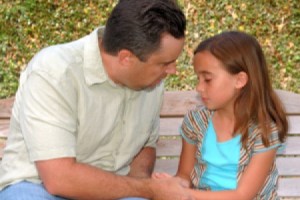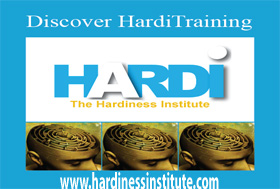
Author’s note: In January 1989, my first wife died as a result of injuries she received in an automobile accident. In the blink of an eye I found myself the single father of a seven year-old daughter – stripped of the presumed partnership of parenthood.
From the moment I told my daughter that her mom was not coming home with us – that her mom was dead – she asked me questions. Questions that demanded answers! Questions that stretched my faith! Questions that pushed my comprehension! Questions that defined my destiny!
The following outlines the first of many, many Crucial Conversations I had with my dear daughter based on her questions. It may help you work with children or even yourself in the face of challenging circumstances.
I frequently share with clients that perhaps the exercise of asking the question may actually be more important than having a ready answer to a situation as we deal with the difficulties of life. I am not talking about why questions! Why questions tend to set up the possibility of rambling around in “loop logic!” You know what I mean! We ask, “Why me? Why this? Why now?” When we ask such questions we frequently meander through tried yet wholly untested theories of the purpose or meaning of an incident. We speculate on the reasons for the disaster, never come to terms with important issues related to the event and finally settle for worn clichés in which we attempt to gather comfort, solace and direction. I don’t know about you, but that just doesn’t cut it for me!
I will never forget breaking the news to my daughter that her mother was dead! It was the single most difficult thing I have ever done in my life! As the weight of that reality bore down on us, we held on to one another and wept. After the initial wave of emotion was replaced by an eerie silence, she asked an extremely profound question as we sat alone in the waiting room. In a timid voice tinged with uncertainty, she asked, “What do we do now, Daddy?” I had never felt so helpless – so alone in my whole life as I did in that moment! I desperately searched for words to respond to my dear child. In that bleak instant, as she was asking me that question, I was asking the same question of God! In the deepest part of my spirit, I desperately asked, “What do we do NOW, Daddy?”
Wouldn’t it be special if I were able to tell you that I received an immediate answer that outlined each and every step I was to take in the coming weeks and months? Wouldn’t it? Didn’t happen that way – I can certainly attest to that fact!
What did happen in that moment of honest questioning was a sense that as long as I kept asking the right kinds of questions – what, how, when – I would find a path to follow that would ultimately lead to healing for both my daughter and me. For whatever reason I determined that asking “why” questions would only lead to more confusion.
Let me share with you what I discovered when my daughter asked, “What do we do now, Daddy?”
Practical thoughts and ideas began to filter through the confusion and bubble to the surface of my consciousness and I responded, “I’m not really sure what we will do, honey; but I know this ~ we have our faith; we have our family and friends; and we have each other and we’re going to make it!” My initial response to her revealed that there were four environments on which I must work in order establish a suitable framework within which my daughter and I could conduct our work of mourning. These environments were:
- Stability – I discovered that I needed to establish some sort of environment of stability for myself so that I could then help construct and communicate that with her as well. Notice I said, with her and not to her. I quickly learned that although our needs were similar, as a child she had a unique set of needs that I had to work to understand. I had to model for her that I was creating stability for myself and in so doing creating the possibility for her to build on that stability while tweaking it for her own personal needs. The best way I knew to do this was to begin each day by taking inventory of the things that I did not know and the things I did know. In my answer to Kacie, I said, “I’m not really sure what we will do, honey; but I know this . . .” By acknowledging and admitting what I did not know, I was able to focus on what I knew to be true and available. That focus helped establish a sense of stability that we both needed so desperately!
- Security – Holding on to some remnant of “sameness” is so very vital to the healing process! When everything on which we have come to depend is suddenly thrown in the air, establishing a sense of security cannot be emphasized enough. I had to determine that we were not alone in our struggle to make sense of our situation and heal. I told her, “We have our faith” which helped to create a sense that we would be able to filter all of our struggles through some foundational concepts from which we could draw strength and guidance as we walked through that valley touched by the shadow of death. True faith stands up to tough questions – it invites questions! True faith promises strength to go through the heart of our struggles – not fancy, flowery detours or short-cuts. True faith creates a sense of stability for our work of mourning.
- Safety – Safety here refers to the feeling that I can say anything I feel like saying in the aftermath of a loss and not worry about the reaction I will receive – the sense that as I work to create meaning through my mourning, I do not have to fear being judged for my words, actions or feelings. Now this task is not always easy. There are many around us who are completely uncomfortable with talk of death, loss or grief in any context. Those are certainly not the folks I want to spend a lot of time with or have my children spend time with. In my answer to Kacie, I said, “we have our family and friends” and I made sure that we spent most of our time with “safe” people – people who allowed and encouraged our expressions of grief without filter.
- Structure – Perhaps the most difficult task is the creation of a new normal in which to rebuild life after the death of a loved one. That task requires a certain amount of structure. It requires more questions – “How is this working? What has really changed? What remains the same? How do I know the difference? To whom do I need to turn for support? When do I take that step?” These are just examples of the types of questions that help create structure for grief reconciliation. When I told Kacie, “and we have each other and we’re going to make it“ I was referring to finding a new structure – a new normal – in which the two of us could work together and live. It is impossible to recreate life as we knew it because it has changed drastically! A new structure is required.
The children in your life can benefit from this approach. The child within YOU can benefit from this process.
As difficult as it may be, I encourage you to ask the tough questions – the what, how, when questions that serve as the foundation upon which you will build the stability, security, safety and structure you need in order to experience healing through grief reconciliation. Ask the what, how, when and then go about the business of discovering your answers. They will come and more often than not, in ways and from sources you least expect! The important thing is to ask the questions.
Where are you today? Are you stuck in the muck and mire of “why, why, why?” Would you be willing to start with just one, “what” question? Just ask and ask and ask? I am convinced that this exercise might just be the one to help you move further down the path of healing and reconciliation.
If you like my post today, please let me know by clicking the Like button that immediately. I welcome your thoughts and comments. Mark Hundley, M.Ed., LPC-S.
Note from Dr. Deborah: I highly recommend Mark’s book called Awaken to Mourning. He shows us through his own experience, wisdom, and learning how to grow from mourning in meaningful and transforming ways.
You can also find Mark at McKinney Counseling Services and Journey of Hope Grief Support Center.






Thank you for posting this blog. I am really sorry for your loss. My prayers and thoughts are with you and your family. How is your little girl doing now ( if I may ask)?
Thank you for your kind words. Although the event that cast us into the cauldron occurred more than 23 years ago, it often seems like a recent event. My daughter is now 30, a high school teacher and mother herself. She has done well and continues to grow as a person. She struggled through her high school years and has on occasion as an adult; however, her personal resolve and coping skills have allowed her to reconcile and integrate her mother’s death. In the same ways that loss can have life-long impact, the healthy mourning strategies can equal or exceed the potential negative of such a loss! Again, thank you for sharing!
Thank you Mark for sharing how you and your daughter went through the loss and thrived inspite of it. Warmly, Deborah.
Mark and I started our life together a little more than 21 years ago. In those years Mark’s stories, speeches, articles, and ability to captivate audiences always leaves me appreciative of his sincere, genuine and authentic desire to deliver the compelling message “LIFE CAN BE GOOD” to the masses.
Hello Vanessa, indeed, life can be good, especially when people dedicate themselves to doing the best they can with whatever happens to them. Mark’s life is a testimony to those words. I’m not surprised that he found love again. I’m happy for both of you, Vanessa. Thank you so much leaving me a comment. Warmly, Deborah.